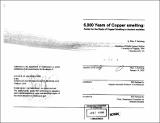6,000 years of copper smelting : Center for the Study of Copper Smelting in Ancient Societies
Author(s)
Steinberg, Marc J. (Marc Jonathan), 1969-
DownloadFull printable version (30.98Mb)
Alternative title
Six thousand years of copper smelting
Center for the Study of Copper Smelting in Ancient Societies
Other Contributors
Massachusetts Institute of Technology. Dept. of Architecture.
Advisor
Bill Hubbard, Jr.
Terms of use
Metadata
Show full item recordAbstract
In 1959 professor of archeology Beno Rothenberg began investigating the production of copper in the Sinai desert and Aravah region of southern Israel. He discovered over 650 previously unknown ancient copper mining and smelting sites. The Timna Valley is one of the most significant sites discovered and is believed to be the first site of copper production, beginning six-thousand years ago. Within this rich historical context, I propose to build an international center for desert studies and copper production in ancient societies. Faculty, students, and researchers will examine desert climate, vegetation, and wildlife. Equally important, they will study the process of mining and smelting copper. The center will also be open to individual tourists and larger groups. Following an introductory lecture, tourists will produce their own small samples of copper. The architecture of the building is driven from the nature of the smelting process. In this process, copper is chemically separated from impurities in a smelting furnace. Heavy metallic copper sinks to the bottom of the furnace. Slag forms above the copper and gas evaporates. The layers of the building mimic this process and are made from copper, slag, and glass. The overall design theme of the building also seeks to demonstrate a clear interaction between building, landscape, and environment.
Description
Thesis (M. Arch.)--Massachusetts Institute of Technology, Dept. of Architecture, 2000. Includes bibliographical references (p. 95).
Date issued
2000Department
Massachusetts Institute of Technology. Department of ArchitecturePublisher
Massachusetts Institute of Technology
Keywords
Architecture.